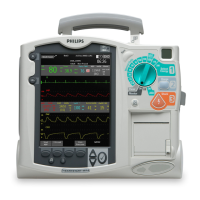Alarms 2 Getting Acquainted
25
Alarms
The HeartStart MRx provides various alarm types indicating changes in patient condition or device/
cable conditions which may require attention. Table 3 details different alarm types.
Table 3 HeartStart MRx Alarm Types
NOTE The presence of multiple alarm conditions is quite possible. Announcing all of the detected alarms
would cause confusion and a less serious condition might hide a more serious condition. For this
reason, alarms are prioritized and categorized so that the most serious or highest priority alarm
condition is the one announced. If multiple same-parameter, same-priority alarms occur, all alarms will
be displayed.
NOTE Audio is suppressed for INOP alarms for the first 60 seconds after the HeartStart MRx is turned on.
INOP messages do appear on the display.
Responding to Alarms
Alarm limits are displayed with each parameter if alarms for the parameter are on. When an alarm
condition occurs and an alarm is indicated, visually and audibly, there are several ways to respond.
Initially:
1 Attend to the patient.
2 Identify the alarm(s) indicated.
3 Silence the alarm(s). When a physiological alarm is announced, the audio pause label (see Figure
13) is displayed above the Navigation and Menu Select buttons. Pressing any of these buttons will
silence the audio for all active alarms while you are attending to the patient. If the alarming
condition continues to exist, it will re-alarm in two minutes. Silencing a specific alarm does not
prevent another alarm condition from sounding. If you also silence the second alarm, it resets the
two-minute audio pause for all active alarms.
When an INOP is announced without a concurrent physiological alarm, the audio off label is
displayed above the Navigation and Menu Select buttons. Pressing any of these buttons will silence
Type of Alarm Condition
Red
High priority. Life-threatening alarm condition is present. Immediate operator response is required.
Red alarm message; alarm tone.
Yellow
Medium priority. Non life-threatening alarm condition is present. Prompt operator response is
required. Yellow alarm message; alarm tone.
INOP
Low priority. Most technical alarms are grouped together as INOPs and are handled as low priority
alarms indicating a problematic condition exists related to the ability of part or all of the device to
perform its intended monitoring function. Operator awareness is required. Exception: conditions
which stop or may stop the delivery of pacing therapy and invasive pressure disconnect. These are
classified as high priority technical alerts. They are potentially life-threatening conditions.
Latching
Alarm is announced and remains present regardless of whether the alarm condition continues to
exist. A latching alarm is not removed until it is either acknowledged or a higher priority alarm
condition occurs.
Non-latching
Alarm is automatically removed when the alarm condition no longer exists.

